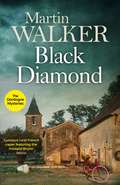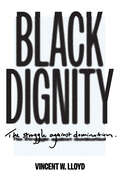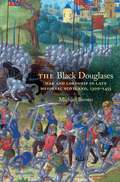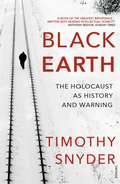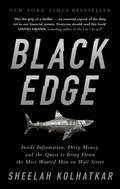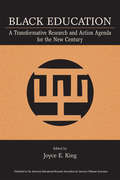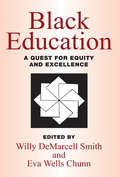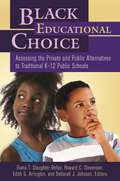- Table View
- List View
Black Democracy: The Story of Haiti (Routledge Library Editions: Revolution #4)
by H.P. DavisThis book, first published in 1929, examines the history of Haiti and its long struggle for independence. The revolution against the French is treated in some detail, as is the story of the free Haitian republic that followed. Building a new country from slavery was no easy task, and another revolutionary period followed in the early twentieth century, which is also analysed alongside its aftermath.
Black Democracy: The Story of Haiti (Routledge Library Editions: Revolution #4)
by H.P. DavisThis book, first published in 1929, examines the history of Haiti and its long struggle for independence. The revolution against the French is treated in some detail, as is the story of the free Haitian republic that followed. Building a new country from slavery was no easy task, and another revolutionary period followed in the early twentieth century, which is also analysed alongside its aftermath.
Black Demons: The Media's Depiction of the African American Male Criminal Stereotype (Crime, Media, and Popular Culture)
by Dennis RomeThe stereotype of the African American male as a criminal element in society continues to be a major obstacle to greater racial harmony and the elimination of discrimination and racism on all levels in the United States. Often, this criminal stereotype is internalized by African American youth, so they are made to feel as though delinquent behavior is expected from them, and many fall into this trap. Black Demons examines this stereotype and contends that much of the blame for its perpetuation comes from U.S. mass media's negative depictions of African American males. Rome argues that these images foster the myths that help to deepen and strengthen the stereotypes that have plagued the African American community since colonial times. By examining the origins of this criminal stereotype, how it has been used historically, and how it is presently employed, Rome reveals a dangerous current in media depictions of African Americans, one that threatens that community and taints U.S. society as it tries to overcome the legacy of racism.The African American male criminal stereotype continues to be used to justify covert and overt racism in contemporary U.S. society. From television to cinema, music to news coverage, mass media continue to depict African American males running from the law, committing crimes, victimizing women, and generally engaging in illegal behavior. Here, Rome examines those images and offers an explanation for this phenomenon. He discusses the impact of these images on both the African American community and on U.S. society in general. He considers the notion that there is a black pathology, a fundamental weakness in African American families that can be traced back to their experiences as slaves. Finally, he concludes that both the news media and entertainment outlets must discontinue their practice of equating young African American males with aggressiveness, lawlessness, and violence if racism is every to be truly abolished in the United States.
Black Designers in American Fashion
by Elizabeth WayFrom Elizabeth Keckly's designs as a freewoman for Abraham Lincoln's wife to flamboyant clothing showcased by Patrick Kelly in Paris, black designers have made major contributions to American fashion. However, many of their achievements have gone unrecognized. This book, inspired by the award-winning exhibition at the Museum at FIT, uncovers hidden histories of black designers at a time when conversations about representation and racialized experience in the fashion industry have reached all-time highs.In chapters from leading and up-and-coming authors and curators, Black Designers in American Fashion uses previously unexplored sources to show how black designers helped build America's global fashion reputation. From enslaved 18th-century dressmakers to 20th-century “star” designers, via independent modistes and Seventh Avenue workers, the book traces the changing experiences of black designers under conditions such as segregation, slavery, and the civil rights movement. Black Designers in American Fashion shows that within these contexts black designers maintained multifaceted practices which continue to influence American and global style today.Interweaving fashion design and American cultural history, this book fills critical gaps in the history of fashion and offers insights and context to students of fashion, design, and American and African American history and culture.
Black Designers in American Fashion
From Elizabeth Keckly's designs as a freewoman for Abraham Lincoln's wife to flamboyant clothing showcased by Patrick Kelly in Paris, black designers have made major contributions to American fashion. However, many of their achievements have gone unrecognized. This book, inspired by the award-winning exhibition at the Museum at FIT, uncovers hidden histories of black designers at a time when conversations about representation and racialized experience in the fashion industry have reached all-time highs.In chapters from leading and up-and-coming authors and curators, Black Designers in American Fashion uses previously unexplored sources to show how black designers helped build America's global fashion reputation. From enslaved 18th-century dressmakers to 20th-century “star” designers, via independent modistes and Seventh Avenue workers, the book traces the changing experiences of black designers under conditions such as segregation, slavery, and the civil rights movement. Black Designers in American Fashion shows that within these contexts black designers maintained multifaceted practices which continue to influence American and global style today.Interweaving fashion design and American cultural history, this book fills critical gaps in the history of fashion and offers insights and context to students of fashion, design, and American and African American history and culture.
Black Diamond: Bruno, Chief of Police 3 (Bruno, Chief of Police #3)
by Martin WalkerAt the heart of French gastronomy lies the famed black truffle of the Périgord. But France's truffles are being adulterated with cheaper ones from China, and it seems that Chinese organised crime is behind the fraud. The third internationally bestselling case for Bruno, Chief of Police.In St Denis market, a Vietnamese family has been selling their dishes for years, until their stall is wrecked by attackers who look Chinese. Again it appears that organised crime is behind the outrage, firing the opening shots of a Viet-Chinese triad war. When vicious murder, illegal immigration and the importation of underage girls for prostitution are added to the mix, Bruno has his work cut out to keep St Denis from tearing itself apart.
Black Diamonds: The Rise and Fall of an English Dynasty
by Catherine BaileyWentworth is in Yorkshire and was surrounded by 70 collieries employing tens of thousands of men. It is the finest and largest Georgian house in Britain andbelonged to the Fitzwilliam family. It is England's forgotten palace which belonged to Britain's richest aristocrats. Black Diamonds tells the story of its demise: family feuds, forbidden love, class war, and a tragic and violent death played their part. But coal, one of the most emotive issues in twentieth century British politics, lies at its heart. This is the extraordinary story of how the fabric of English society shifted beyond recognition in fifty turbulent years in the twentieth century.
The Black Digital Elite: African American Leaders of the Information Revolution
by John T. BarberMost discussions of the digital divide focus on the gap between African Americans and others when it comes to using, and benefiting from, the technological and business opportunities of the information age. Although many African Americans are locked out of the information revolution, others are an integral part of its development and progress. Barber profiles 26 of those leaders here, engagingly and informatively blending biography with insight and analysis.Most discussions of the digital divide focus on the gap between African Americans and others when it comes to using, and benefiting from, the technological and business opportunities of the information age. Although many African Americans are locked out of the information revolution, others are an integral part of its development and progress. Barber profiles 26 of them here, engagingly and informatively blending biography with insight and analysis.Documenting history as it is being made, this book features achievers in all fields of relevant endeavor, including scientists, business leaders, power brokers, and community leaders. Among them are Robert Johnson, CEO of Black Entertainment Television; Richard Parsons, CEO of AOL Time-Warner; congressmen and other policymakers in Washington, D.C.; and men and women who are working to bridge the digital divide in satellite radio, web-based portals, and on the ground with IT workshops. This book is not just about business success or technological progress. The African American digerati are solving one of the great social challenges of the 21st century: creating a black community that is prosperous in a society that has changed from being a land-based industrial society to a cyberspace-based information society.
Black Dignity: The Struggle against Domination
by Vincent W. LloydWhy Black dignity is the paradigm of all dignity and Black philosophy is the starting point of all philosophy This radical work by one of the leading young scholars of Black thought delineates a new concept of Black dignity, yet one with a long history in Black writing and action. Previously in the West, dignity has been seen in two ways: as something inherent in one’s station in life, whether acquired or conferred by birth; or more recently as an essential condition and right common to all of humanity. In what might be called a work of observational philosophy—an effort to describe the philosophy underlying the Black Lives Matter movement—Lloyd defines dignity as something performative, not an essential quality but an action: struggle against domination. Without struggle, there is no dignity. He defines anti-Blackness as an inescapable condition of American life, and the slave’s struggle against the master as the “primal scene” of domination and resistance. Exploring the way Black writers such as Frederick Douglass, Langston Hughes, and Audre Lorde have dealt with themes such as Black rage, Black love, and Black magic, Lloyd posits that Black dignity is the paradigm of all dignity and, more audaciously, that Black philosophy is the starting point of all philosophy.
Black Diplomacy: African Americans and the State Department, 1945-69
by Michael KrennThis text covers integration of the State Department after 1945 and the subsequent appointments of Black ambassadors to Third World and African nations. Other topics include: the setbacks during the Eisenhower years and the gains achieved during the Kennedy and Johnson administrations.
Black Diplomacy: African Americans and the State Department, 1945-69
by Michael KrennThis text covers integration of the State Department after 1945 and the subsequent appointments of Black ambassadors to Third World and African nations. Other topics include: the setbacks during the Eisenhower years and the gains achieved during the Kennedy and Johnson administrations.
Black Dog of Fate: A Memoir
by Peter BalakianIn this tenth anniversary edition of his award-winning memoir, New York Times bestselling author Peter Balakian has expanded his compelling story about growing up in the baby-boom suburbs of the '50s and '60s and coming to understand what happened to his family in the first genocide of the twentieth century—the Ottoman Turkish government's extermination of more than one million Armenians in 1915. In this new edition, Balakian continues his exploration of the Armenian Genocide with new chapters about his journey to Aleppo and his trip to the Der Zor desert of Syria in his pursuit of his grandmother's life, bringing us closer to the twentieth century's first genocide.
The Black Dog Summer on the Vineyard Cookbook
by Elaine Sullivan Joseph HallThe first cookbook from The Black Dog Tavern contains a collection of recipes from the summertime menu of this Martha's Vineyard restaurant, which has been deemed a true American institution. 75 color photos, 25 line drawings.
The Black Door: Spies, Secret Intelligence And British Prime Ministers
by Richard Aldrich Rory CormacThe Black Door explores the evolving relationship between successive British prime ministers and the intelligence agencies, from Asquith’s Secret Service Bureau to Cameron’s National Security Council.
The Black Douglases: War and Lordship in Medieval Scotland 1300–1455
by Michael BrownDuring the century and a half of their power the Black Douglases earned fame as Scotland’s champions in the front line of war against England. On their shields they bore the bloody heart of Robert Bruce, the symbol of their claim to be the physical protectors of the hero-king’s legacy. But others saw the power of these lords and earls of Douglas in a different light. To their critics the Douglases were a force for disorder in the kingdom, lawless, arrogant and violent, whose power rested on coercion and whose defiance of kings and guardians ultimately provoked James II into slaying the Douglas earl with his own hand.Michael Brown analyses the rise and fall of this family as the dominant magnates of the south, from the deeds of the Good Sir James Douglas in the service of Bruce to the violent destruction of the Douglas earls in the 1450s. Alongside this study of the accumulation and loss of power by one of the great noble houses, The Black Douglases includes a series of thematic examinations of the nature of aristocratic power. In particular these emphasise the link between warfare and political power in southern Scotland during the fourteenth century. For the Black Douglases, war was not just a patriotic duty but the means to power and fame in Scotland and across Europe.
The Black Earth: Ecological Principles for Sustainable Agriculture on Chernozem Soils (International Year of Planet Earth)
by Igori Arcadie Krupenikov Boris P Boincean David DentSoil is the Earth’s living skin. It provides anchorage for roots, holds water long enough for plants to make use of it and the nutrients that sustain life – otherwise the Earth would be as barren as Mars. It is home to myriad micro-organisms and armies of microscopic animals as well as the familiar earthworm that accomplish biochemical transformations from fixing atmospheric nitrogen to recycling wastes; it receives and process all fresh water, provides the foundations for our built environment; and comprises the biggest global carbon store that we know how to manage. This book is about the best soil in the world - the black earth or chernozem: how it is being degraded by farming and how it may be farmed sustainably. Industrialisation of farming has laid bare contradictions between the unforgiving laws of ecology and economics. Soil organic matter is the fuel that powers soil systems and the cement that holds the soil together – and in place – but agriculture is burning it up faster than it is being formed: even the chernozem cannot long survive this treatment. Here is the evidence for this trend and, based on long-term field experiments, ecological principles for sustainable agriculture that can reverse the trend and, at the same time, feed the world. Unlike other volumes in the series, this is not an edited collection of scientific papers. The authors have chosen the classical monograph to be near to the reader from beginning to end - to convey their anxiety about the state of the land and their optimism about the possibility of retrieving the situation by changing the social and political approach to the land so as to provide the necessary incentives for sustainable land use and management.
Black Earth: A Journey Through Russia After The Fall
by Andrew MeierDue to the level of detail, maps are best viewed on a tablet.
Black Earth: The Holocaust as History and Warning
by Timothy SnyderLONGLISTED FOR THE 2015 SAMUEL JOHNSON PRIZE We have come to see the Holocaust as a factory of death, organised by bureaucrats. Yet by the time the gas chambers became operation more than a million European Jews were already dead: shot at close range over pits and ravines. They had been murdered in the lawless killing zones created by the German colonial war in the East, many on the fertile black earth that the Nazis believed would feed the German people.It comforts us to believe that the Holocaust was a unique event. But as Timothy Snyder shows, we have missed basic lessons of the history of the Holocaust, and some of our beliefs are frighteningly close to the ecological panic that Hitler expressed in the 1920s. As ideological and environmental challenges to the world order mount, our societies might be more vulnerable than we would like to think.Timothy Snyder’s Bloodlands was an acclaimed exploration of what happened in eastern Europe between 1933 and 1945, when Nazi and Soviet policy brought death to some 14 million people. Black Earth is a deep exploration of the ideas and politics that enabled the worst of these policies, the Nazi extermination of the Jews. Its pioneering treatment of this unprecedented crime makes the Holocaust intelligible, and thus all the more terrifying.
Black Earth City: A Year in the Heart of Russia
by Charlotte HobsonEach chapter is a bonne bouche, possessing its own particular flavour, from sweet to acrid-bitter. Hobson's characters are often wonderfully quixotic and so is the spirit she finds everywhere at this crux in Russia's history. She drinks with derelicts, hangs out with gypsies, and watches investigators go about the grim business of exhuming purge victims, and giving them the Christian burial they have been denied for seventy years. Her style is deft: she manages to render the scenes through which she passes with needle-sharp precision.' Financial TimesThis witty and yet deeply moving, acutely observed tale of Charlotte Hobson's year in Russia takes us to the heart of a country many of us continue to be fascinated by and struggle to understand. Or as the TLS put it: 'Hobson writes with such beguiling directness that it is hard not to feel intimate with her and her characters. Few books evoke so much of Russian life, with so little effort.
Black Edge: Inside Information, Dirty Money, and the Quest to Bring Down the Most Wanted Man on Wall Street
by Sheelah KolhatkarNominated for the FT/McKinsey Business Book of the YearNominated for the Carnegie Medal for Excellence in NonfictionAmazon Top 5 Business Books of 2017'A prodigious feat of reporting' - Malcolm Gladwell‘Black Edge has the grip of a thriller … Everyone should read this book’ - David Grann, New York Times bestselling author of THE LOST CITY OF Z How do super-rich bankers get away with it?There is a powerful new class of billionaire financiers in the world, who use their phenomenal wealth to write their own rules and laws. Chief among them is Steven Cohen, a Wall Street legend, and the basis for Damian Lewis's character in BILLIONS, who built his hedge fund into a $15 billion empire on the basis of wizard-like stock trading, and who flies to work by helicopter and owns one of the largest private art collections in the world. But his iconic status was shattered when his fund became the target of a sprawling FBI investigation into insider trading, charged with using illegal inside information – or ‘black edge’ – to beat the market. His firm, SAC Capital, was ultimately indicted and pled guilty to charges of securities and wire fraud, and paid record criminal and civil fines of nearly $2 billion. But even as the company bearing his name pled guilty, Cohen himself was never charged, and is free to start trading publicly again from January 2018.Black Edge offers a revelatory look at the grey zone in which so much of Wall Street functions, and a window into the transformation of the worldwide economy. With meticulous reporting and powerful storytelling, this is a riveting, true-life legal thriller that takes readers inside the US government’s pursuit of Cohen and his employees, and raises urgent questions about the power and wealth of those who sit at the pinnacle of the financial world.
Black Education: A Transformative Research and Action Agenda for the New Century
by Joyce E. KingThis volume presents the findings and recommendations of the American Educational Research Association's (AERA) Commission on Research in Black Education (CORIBE) and offers new directions for research and practice. By commissioning an independent group of scholars of diverse perspectives and voices to investigate major issues hindering the education of Black people in the U.S., other Diaspora contexts, and Africa, the AERA sought to place issues of Black education and research practice in the forefront of the agenda of the scholarly community. An unprecedented critical challenge to orthodox thinking, this book makes an epistemological break with mainstream scholarship. Contributors present research on proven solutions--best practices--that prepare Black students and others to achieve at high levels of academic excellence and to be agents of their own socioeconomic and cultural transformation. These analyses and empirical findings also link the crisis in Black education to embedded ideological biases in research and the system of thought that often justifies the abject state of Black education.Written for both a scholarly and a general audience, this book demonstrates a transformative role for research and a positive role for culture in learning, in the academy, and in community and cross-national contexts. Volume editor Joyce E. King is the Benjamin E. Mays Endowed Chair of Urban Teaching, Learning and Leadership at Georgia State University and was chair of CORIBE. Additional Resources Black Education [CD-ROM]Research and Best Practices 1999-2001Edited byJoyce E. KingGeorgia State UniversityInformed by diverse perspectives and voices of leading researchers, teacher educators and classroom teachers, this rich, interactive CD-ROM contains an archive of the empirical findings, recommendations, and best practices assembled by the Commission on Research in Black Education. Dynamic multi-media presentations document concrete examples of transformative practice that prepare Black students and others to achieve academic and cultural excellence. This CD-ROM was produced with a grant from the SOROS Foundation, Open Society Institute.0-8058-5564-5 [CD-ROM] / 2005 / Free Upon Request A Detroit Conversation [Video]Edited byJoyce E. KingGeorgia State University In this 20-minute video-documentary a diverse panel of educators--teachers, administrators, professors, a "reform" Board member, and parent and community activists--engage in a "no holds barred" conversation about testing, teacher preparation, and what is and is not working in Detroit schools, including a school for pregnant and parenting teens and Timbuktu Academy. Concrete suggestions for research and practice are offered.0-8058-5625-0 [Video] / 2005 / $10.00 A Charge to Keep [Video]The Findings and Recommendations of te AERA Commission on Research in Black EducationEdited byJoyce E. KingGeorgia State University This 50-minute video documents the findings and recommendations of the Commission on Research in Black Education (CORIBE), including exemplary educational approaches that CORIBE identified, cameo commentaries by Lisa Delpit, Gloria Ladson-Billings, Kathy Au, Donna Gollnick, Adelaide L. Sanford, Asa Hilliard, Edmund Gordon and others, and an extended interview with Sylvia Wynter.0-8058-5626-9 [Video] / 2005 / $10.00
Black Education: A Transformative Research and Action Agenda for the New Century
by Joyce E. KingThis volume presents the findings and recommendations of the American Educational Research Association's (AERA) Commission on Research in Black Education (CORIBE) and offers new directions for research and practice. By commissioning an independent group of scholars of diverse perspectives and voices to investigate major issues hindering the education of Black people in the U.S., other Diaspora contexts, and Africa, the AERA sought to place issues of Black education and research practice in the forefront of the agenda of the scholarly community. An unprecedented critical challenge to orthodox thinking, this book makes an epistemological break with mainstream scholarship. Contributors present research on proven solutions--best practices--that prepare Black students and others to achieve at high levels of academic excellence and to be agents of their own socioeconomic and cultural transformation. These analyses and empirical findings also link the crisis in Black education to embedded ideological biases in research and the system of thought that often justifies the abject state of Black education.Written for both a scholarly and a general audience, this book demonstrates a transformative role for research and a positive role for culture in learning, in the academy, and in community and cross-national contexts. Volume editor Joyce E. King is the Benjamin E. Mays Endowed Chair of Urban Teaching, Learning and Leadership at Georgia State University and was chair of CORIBE. Additional Resources Black Education [CD-ROM]Research and Best Practices 1999-2001Edited byJoyce E. KingGeorgia State UniversityInformed by diverse perspectives and voices of leading researchers, teacher educators and classroom teachers, this rich, interactive CD-ROM contains an archive of the empirical findings, recommendations, and best practices assembled by the Commission on Research in Black Education. Dynamic multi-media presentations document concrete examples of transformative practice that prepare Black students and others to achieve academic and cultural excellence. This CD-ROM was produced with a grant from the SOROS Foundation, Open Society Institute.0-8058-5564-5 [CD-ROM] / 2005 / Free Upon Request A Detroit Conversation [Video]Edited byJoyce E. KingGeorgia State University In this 20-minute video-documentary a diverse panel of educators--teachers, administrators, professors, a "reform" Board member, and parent and community activists--engage in a "no holds barred" conversation about testing, teacher preparation, and what is and is not working in Detroit schools, including a school for pregnant and parenting teens and Timbuktu Academy. Concrete suggestions for research and practice are offered.0-8058-5625-0 [Video] / 2005 / $10.00 A Charge to Keep [Video]The Findings and Recommendations of te AERA Commission on Research in Black EducationEdited byJoyce E. KingGeorgia State University This 50-minute video documents the findings and recommendations of the Commission on Research in Black Education (CORIBE), including exemplary educational approaches that CORIBE identified, cameo commentaries by Lisa Delpit, Gloria Ladson-Billings, Kathy Au, Donna Gollnick, Adelaide L. Sanford, Asa Hilliard, Edmund Gordon and others, and an extended interview with Sylvia Wynter.0-8058-5626-9 [Video] / 2005 / $10.00
Black Education: A Quest for Equity and Excellence
by Willy DeMarcell SmithThis highly focused collection of papers, commissioned by the National Urban League, offers a candid and courageous portrait of black education in transition. This is a period, as the editors note in their opening remarks, that is characterized by a huge shift from federal responsibility for minority education to authority and autonomy being lodged at the local government level. Further, many institutions that once worked well, no longer do so. Many ambitious social programs and policies that originally promised much, have been abandoned, have failed, or just faded away. Pivotal to these times and changes is the question of the extent to which the American educational system has been, or still is, capable of being responsive to incorporating and even instigating equity and excellence for black Americans. This volume asks the hard questions: is the educational system geared up for the maintenance of anything other than mainstream values? can it adapt to minority youth requirements? when, why, and how do educational policies of majorities and minorities clash? How are priorities to be established on the basis of wealth or need? The legal statutes and administrative enforcement of equal educational opportunities are explored in depth and with a deep compassion for all parties involved.
Black Education: A Quest for Equity and Excellence
by Willy DeMarcell Smith Eva Wells ChunnThis highly focused collection of papers, commissioned by the National Urban League, offers a candid and courageous portrait of black education in transition. This is a period, as the editors note in their opening remarks, that is characterized by a huge shift from federal responsibility for minority education to authority and autonomy being lodged at the local government level. Further, many institutions that once worked well, no longer do so. Many ambitious social programs and policies that originally promised much, have been abandoned, have failed, or just faded away. Pivotal to these times and changes is the question of the extent to which the American educational system has been, or still is, capable of being responsive to incorporating and even instigating equity and excellence for black Americans. This volume asks the hard questions: is the educational system geared up for the maintenance of anything other than mainstream values? can it adapt to minority youth requirements? when, why, and how do educational policies of majorities and minorities clash? How are priorities to be established on the basis of wealth or need? The legal statutes and administrative enforcement of equal educational opportunities are explored in depth and with a deep compassion for all parties involved.
Black Educational Choice: Assessing the Private and Public Alternatives to Traditional K–12 Public Schools
by James A. BanksThis important book provides African American parents with the knowledge to diversify K–12 school choices beyond traditional neighborhood public schools in order to optimize the educational chances of their own children, and it will help educators and policymakers to close the black-white academic achievement gap throughout America.Closing the K–12 achievement gap is critical to the future welfare of African American individuals, families, and communities—and to the future of our nation as a whole. The black-white academic achievement gap—the significant statistical difference in academic performance between African American students and their white peers—is the single greatest impediment to achieving racial equality and social justice in America.Black Educational Choice provides parents, citizens, educators, and policymakers the critical knowledge they need to leverage the national trend toward increasing and diversifying K–12 school choice beyond traditional neighborhood public schools. Parents can use this information to optimize the success of their own African American children, while policymakers and educators can apply these insights to help close the black-white academic achievement gap throughout America. The book collects the interdisciplinary, multi-racial, and multi-ethnic perspectives of education experts to address the questions of millions of anxious African American families: "Would sending our children to a private school or a charter school significantly better their chances of closing the achievement gap and becoming successful individuals? And if so, what kinds of challenges would they likely experience in these alternative educational settings?"



